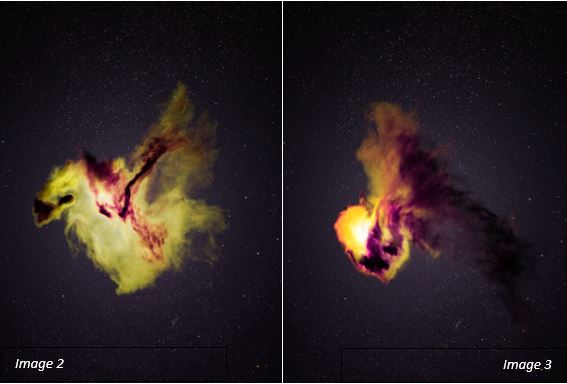ZTF News
Home / ZTF News
ZTF catches a never-before-seen flare of supernova
Sept 4, 2025 | Press release
Depiction of the most likely scenario of SN 2021yfj. Near the end of its life, SN 2021yfj's stripped-to-the-bone progenitor underwent two rare and extremely violent pair-instability episodes, ejecting shells rich in silicon (grey), sulphur (yellow) and argon (purple). The collision of these massive shells is so violent that it created a brilliant supernova that could still be seen at a distance of 2.2 billion light-years from Earth. SN 2021yfj is so unusual it defines a new class, Type Ien, and the star itself may have survived the event. Credit: W.M. Keck Observatory/Adam Makarenko
A large team of astronomers, led by ZTF partners at the Northwestern university stumbled upon a unique explosion of a supernova from a massive star back in Sept 2021. After extensive analysis of the supernova using data from multiple telescopes around the world, the astronomers believe they have seen for the first time the inner layers of a dying star.
Theorists have long posed that stars have a layered structure starting from light elements like hydrogen and helium and moving to heavier elements all the way down to iron as you go deeper in the star. The observed star dubbed SN2021yfj has revealed its sulfur, argon and silicon layers allowing up to peak deeper into the core of a massive star than ever before.
“This is the first time we have seen a star that was essentially stripped to the bone,” said Northwestern’s Steve Schulze, who led the study. “It shows us how stars are structured and proves that stars can lose a lot of material before they explode. Not only can they lose their outermost layers, but they can be completely stripped all the way down and still produce a brilliant explosion that we can observe from very, very far distances.”
Read the full press release from the Northwestern University.
Science paper
Extremely stripped supernova reveals a silicon and sulfur formation site
Contact
Science Contact
Steve Schulze (Research Associate, Northwestern University, USA)
email: steve[dot] schulze [at] northwestern [dot] edu
ZTF Media Contact
Ivona Kostadinova
ZTF Coordinator (Caltech)
email: ivonata [at] caltech [dot] edu
Multimedia

Artist’s illustration of the supernova’s aftermath. Even after the star was stripped down to its core, it continued to experience violent mass-loss episodes, ejecting shells of material rich in silicon (grey), sulfur (yellow), and argon (purple). The catastrophic collision of these massive shells, as depicted in this illustration, generated a brilliant supernova explosion visible across 2.2 billion light-years of space. Credit: Keck Observatory/Adam Makarenko.

